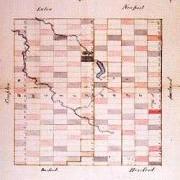 The French Regime:
The French Regime:
During the French regime, the Eastern Townships remained unsurveyed, as French settlers preferred to be as close to the St. Lawrence River as possible. Except for part of Missisquoi County, the area remained outside the seigneurial system, the French system of land tenure. After the American Revolution, the British government preferred to maintain the region as a buffer zone between the new American Republic and recently conquered Quebec.
The Township System:
In 1792, the British decided to open the unsurveyed parts of Quebec (Lower Canada) to settlement. The system of freehold land tenure in Britain and the United States would be employed in these areas, and would distinguish the Eastern Townships from much of the rest of Quebec. Instead of dividing the land into seigneuries granted to feudal lords, the British divided it into townships (10 miles by 10 miles) granted to "leaders." The leader would agree to have his township surveyed into lots of 200 acres, which he would grant in turn to settlers known as "associates."
The system was intended to make good land available at no cost to the government, and at little cost to hard-working pioneers. In theory, a leader would be granted a township only after he had demonstrated that he had enlisted a good number of associates. In practice, those in government and their friends awarded themselves many townships without having any associates to settle the land.
One of the largest landowners was former Lieutenant-Governor Robert Shore Milnes who, in 1810, was rewarded for his services with grants of 21,406 acres in Stanstead Township, 13,546 in Barnston, and 13,110 in Compton. By 1838, as few as 105 landowners held 1,500,000 acres in the Eastern Townships, only six of whom actually resided there. Corruption and speculation hindered the early development of the region. It also encouraged squatting.